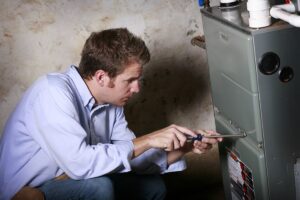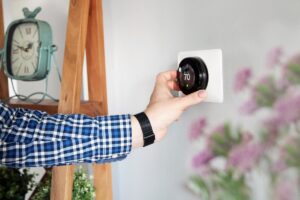So, Jennifer thinks the room is too cold, while Jessie wants it even cooler? If you’re the proud owner of a single thermostat or HVAC unit for your entire home, you might feel like there needs to be a way to keep everyone happy.

That’s where ductless HVAC zoning comes in. It allows you to control the temperature of each room individually, providing customized comfort for every member of your household. But that’s not all – it also offers significant energy savings and increased efficiency for your heating and cooling system.
How Does Ductless HVAC Zoning Work?
Ductless HVAC zoning is an innovative technology that allows you to control the temperature in different areas or zones of your home independently. It involves installing multiple indoor units connected to a single outdoor unit, each dedicated to a specific zone.
This means you can set different temperatures for each room or area, ensuring optimal comfort and energy efficiency. Let’s take a look at how this technology works.
What Are The Different Components of a Ductless HVAC System
A ductless HVAC zoning system consists of three main components:
- Outdoor Unit: This is the system’s heart and is responsible for cooling or heating the air. It is usually installed on a wall outside your home.
- Indoor Units: Compact units mounted on walls or ceilings within each zone. They are connected to the outdoor unit through refrigerant lines and require no ductwork.
- Thermostat: Each indoor unit has its own thermostat, allowing you to set the temperature for that particular zone.
Understanding the Function of the Indoor Air Handling Units
The indoor air handling units are the key components of a ductless HVAC zoning system. These units are designed to control the temperature in each zone by blowing out cool or warm air as needed.
They work by drawing in the air from the room, passing it through a filter, and then pushing it back into the room at the desired temperature. The thermostat on each unit allows you to adjust the temperature and control the fan speed.
The Benefits of Ductless HVAC Zoning Systems
Ductless HVAC zoning systems offer substantial advantages over traditional ones, making them an increasingly popular choice among homeowners. From improved energy efficiency to enhanced comfort, the benefits are many and cannot be ignored.
Let’s take a look at some of the most important.
Increased Energy Efficiency
One of the biggest advantages of a ductless HVAC zoning system is its energy efficiency. Since each zone has its own thermostat, you have precise control over the temperature in different areas of your home. This means you can adjust the temperature based on occupancy and usage patterns, lowering energy consumption and reducing utility bills.
Enhanced Comfort Levels
With traditional HVAC systems, it’s not uncommon for certain areas of the house to feel too hot or cold. This is because a single thermostat controls the temperature for the entire home, making it difficult to maintain consistent comfort levels in different zones. However, with a ductless zoning system, you can set individual temperatures for each zone, ensuring everyone in your household stays comfortable.
Improved Indoor Air Quality
Ductless HVAC systems use advanced filtration technology to remove dust, allergens, and other pollutants from the air. This ensures that the air circulating in your home is clean and healthy, reducing the risk of respiratory issues and allergies. Additionally, since no ducts are involved, there’s no risk of dust buildup or mold growth inside the ductwork, further improving indoor air quality.
Cost Savings
While ductless zoning systems may have a higher upfront cost than traditional HVAC systems, they can save you money in the long run. The energy efficiency of these systems translates into lower utility bills, and their long lifespan means you won’t have to incur frequent repair or replacement costs. Moreover, many homeowners are eligible for tax credits and rebates when installing energy-efficient systems, which can further reduce costs.
Easy Installation and Maintenance
Installing a ductless HVAC system is relatively easy compared to traditional systems that require extensive ductwork. This makes it a popular choice for retrofitting old homes or adding additional rooms to an existing house. Additionally, since each indoor unit operates independently, the rest of the system can continue to function normally if one unit requires maintenance or repair.
How to Optimize Ductless HVAC Zoning for Maximum Efficiency
To make the most out of your ductless HVAC zoning system, optimizing it for maximum efficiency is important. The following are some tips and strategies that can help enhance the performance and longevity of your system, ensuring that it delivers optimal comfort and energy savings.
Correct Placement of Indoor Units
Proper placement of indoor units plays a crucial role in optimizing your system’s cooling and heating efficiency. Ensuring that indoor units are strategically positioned in areas where airflow is not obstructed, such as away from obstruction and near the center of the room, can help distribute air evenly and enhance the overall comfort of your space.
Optimizing Temperature Settings
Fine-tuning your temperature settings can have a significant impact on your energy consumption. Adjusting the thermostat to slightly higher temperatures in the summer and slightly lower temperatures in the winter can help save energy while maintaining a comfortable indoor environment.
Effective Use of Programmable Thermostats
Programmable thermostats offer the convenience of presetting temperature adjustments based on your schedule. Utilizing the scheduling features and programming temperature setbacks when you are away or asleep can result in substantial energy savings without sacrificing comfort.
Seasonal Adjustments for Maximum Efficiency
Making seasonal adjustments to your HVAC system can help optimize its efficiency. For example, adjusting fan speeds, airflow direction, or humidity settings during different seasons can help your system operate more efficiently and effectively.
By paying attention to these details and implementing these strategies, you can maximize the performance and efficiency of your HVAC system, ensuring a comfortable and cost-effective indoor environment throughout the year.
The Role of Ventilation
Understanding the role of ventilation in maintaining indoor air quality and temperature control can help you manage your HVAC system more effectively. Proper ventilation can prevent the buildup of pollutants and excess moisture, impacting your system’s performance and energy consumption. Regularly changing air filters and ensuring proper airflow can help maintain optimal HVAC system function.
Taking Advantage of Smart Technology
Advancements in technology have led to the development of smart HVAC systems that can be controlled remotely and programmed to adjust settings based on time, occupancy, or outside weather conditions. Taking advantage of these features can further optimize the efficiency of your system. Installing programmable thermostats allows you to set specific temperature schedules for different times of the day or week, helping to reduce unnecessary energy usage and costs.
Regular Maintenance and Cleaning
Regular maintenance and cleaning of your HVAC system can improve its efficiency, reduce the risk of breakdowns, and prolong its lifespan. This includes changing air filters, cleaning coils, and scheduling professional tune-ups. Routine system check-ups by HVAC professionals can identify potential issues before they escalate, ensuring uninterrupted service and prolonging the lifespan of your HVAC system.
A Word From Robert B. Payne
At Robert B. Payne, we understand the importance of ductless HVAC zoning and a well-functioning HVAC system for your home or business. Our team of experienced technicians is dedicated to providing top-quality installation, maintenance, and repair services to ensure your HVAC system operates at its best. Contact us today at 540-373-5876 to learn how we can help you maintain a comfortable and cost-effective indoor environment.






